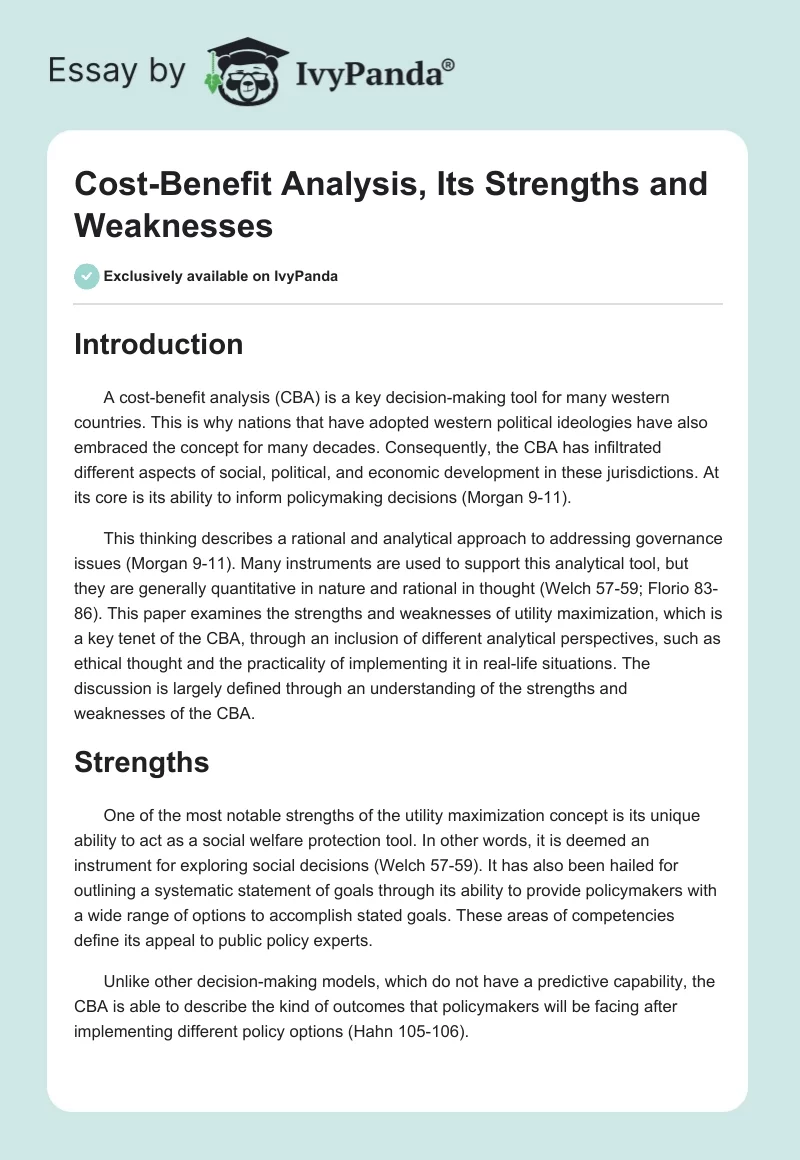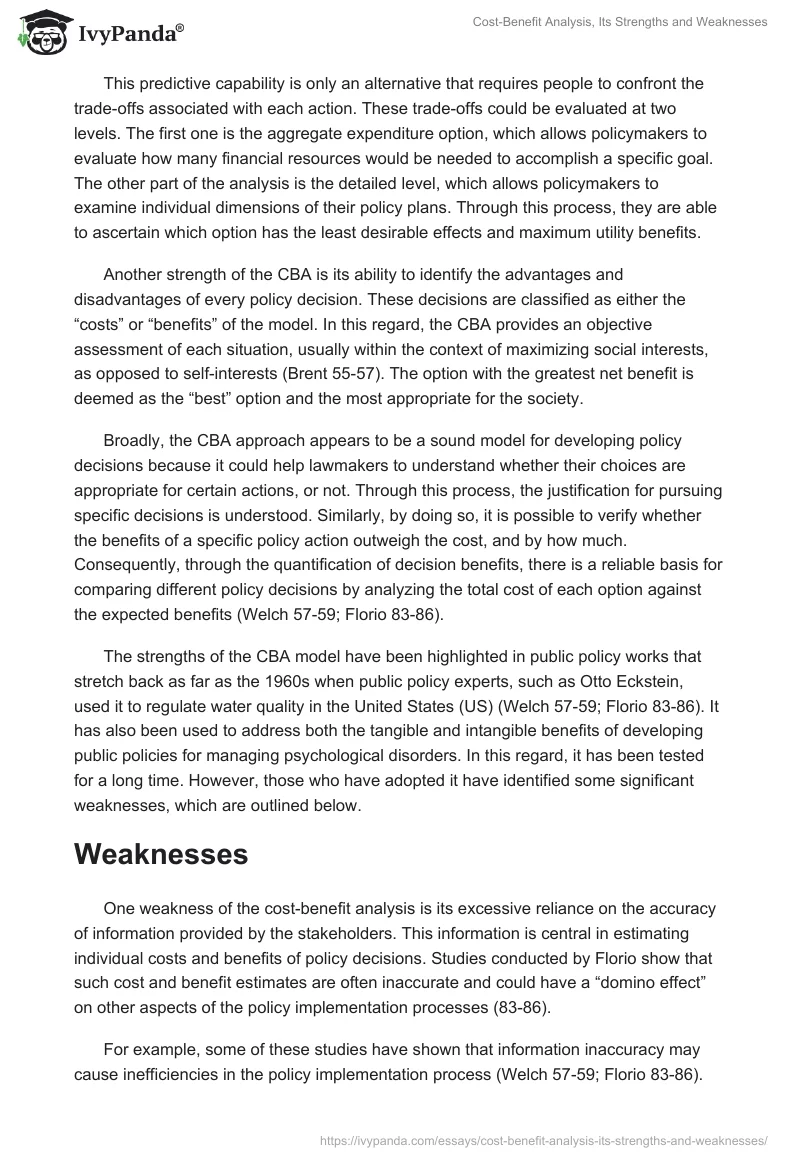Introduction
A cost-benefit analysis (CBA) is a key decision-making tool for many western countries. This is why nations that have adopted western political ideologies have also embraced the concept for many decades. Consequently, the CBA has infiltrated different aspects of social, political, and economic development in these jurisdictions. At its core is its ability to inform policymaking decisions (Morgan 9-11).
This thinking describes a rational and analytical approach to addressing governance issues (Morgan 9-11). Many instruments are used to support this analytical tool, but they are generally quantitative in nature and rational in thought (Welch 57-59; Florio 83-86). This paper examines the strengths and weaknesses of utility maximization, which is a key tenet of the CBA, through an inclusion of different analytical perspectives, such as ethical thought and the practicality of implementing it in real-life situations. The discussion is largely defined through an understanding of the strengths and weaknesses of the CBA.
Strengths
One of the most notable strengths of the utility maximization concept is its unique ability to act as a social welfare protection tool. In other words, it is deemed an instrument for exploring social decisions (Welch 57-59). It has also been hailed for outlining a systematic statement of goals through its ability to provide policymakers with a wide range of options to accomplish stated goals. These areas of competencies define its appeal to public policy experts.
Unlike other decision-making models, which do not have a predictive capability, the CBA is able to describe the kind of outcomes that policymakers will be facing after implementing different policy options (Hahn 105-106).
This predictive capability is only an alternative that requires people to confront the trade-offs associated with each action. These trade-offs could be evaluated at two levels. The first one is the aggregate expenditure option, which allows policymakers to evaluate how many financial resources would be needed to accomplish a specific goal. The other part of the analysis is the detailed level, which allows policymakers to examine individual dimensions of their policy plans. Through this process, they are able to ascertain which option has the least desirable effects and maximum utility benefits.
Another strength of the CBA is its ability to identify the advantages and disadvantages of every policy decision. These decisions are classified as either the “costs” or “benefits” of the model. In this regard, the CBA provides an objective assessment of each situation, usually within the context of maximizing social interests, as opposed to self-interests (Brent 55-57). The option with the greatest net benefit is deemed as the “best” option and the most appropriate for the society.
Broadly, the CBA approach appears to be a sound model for developing policy decisions because it could help lawmakers to understand whether their choices are appropriate for certain actions, or not. Through this process, the justification for pursuing specific decisions is understood. Similarly, by doing so, it is possible to verify whether the benefits of a specific policy action outweigh the cost, and by how much. Consequently, through the quantification of decision benefits, there is a reliable basis for comparing different policy decisions by analyzing the total cost of each option against the expected benefits (Welch 57-59; Florio 83-86).
The strengths of the CBA model have been highlighted in public policy works that stretch back as far as the 1960s when public policy experts, such as Otto Eckstein, used it to regulate water quality in the United States (US) (Welch 57-59; Florio 83-86). It has also been used to address both the tangible and intangible benefits of developing public policies for managing psychological disorders. In this regard, it has been tested for a long time. However, those who have adopted it have identified some significant weaknesses, which are outlined below.
Weaknesses
One weakness of the cost-benefit analysis is its excessive reliance on the accuracy of information provided by the stakeholders. This information is central in estimating individual costs and benefits of policy decisions. Studies conducted by Florio show that such cost and benefit estimates are often inaccurate and could have a “domino effect” on other aspects of the policy implementation processes (83-86).
For example, some of these studies have shown that information inaccuracy may cause inefficiencies in the policy implementation process (Welch 57-59; Florio 83-86). These problems could stem from several areas. However, the overreliance on data from past projects is commonly cited as the main cause (Florio 83-86). Similarly, the use of subjective impressions in undertaking quantitative assessments also poses a challenge to policymakers because it could mislead the in prediction of the effects of certain policy choices inaccurately.
Another weakness of the CBA approach is the difficulty in assessing subjective issues considered in policymaking processes. Indeed, not every variable is quantifiable. Therefore, it is difficult to implement a model that takes into account only quantitative factors in the decision-making process because some variables are subjective in nature (Florio 83-86). In line with this reasoning, the cost-benefit analysis is not entirely objective because it ignores costs that relate to intangible benefits and disadvantages of policy actions.
For example, in many government projects, the environmental and social cost of pursuing policy decisions is usually overlooked because monetary considerations take precedence (Brent 55-57). Indeed, as highlighted by Goulder and Parry, this problem has been witnessed in how governments control pollution within their jurisdictions (1-2).
Lastly, another criticism of the cost-benefit analysis is its inability to merge or align with morality theories (Weimer 29-31). Particularly, theories that promote deontological concepts have been highlighted as being the most incompatible with the cost-benefit analysis because the concept could support human rights violations if they are done to promote others (Florio 83-86; Weimer 29-31). This issue elicits questions about the importance of respecting human rights, and the case when such a principle can be broken. It also explores difficult issues relating to when it is acceptable to violate some people’s rights to safeguard others. Based on these concerns, the CBA model has been cautiously adopted in “sensitive” areas of political and social governance.
Conclusion
This paper has shown that the CBA model is a practical framework for evaluating government decisions. Based on a review of its inner workings, it appears to follow the utilitarian reasoning. It is difficult to accept this concept as a generally accepted framework for undertaking public policy assessments because it is inapplicable in situations where subjective issues suffice. Although it is easy to dismiss it based on some of these ethical weaknesses, its ability to evaluate decisions in monetary terms means that it could still be of value to the public policy field.
Nonetheless, many people could still resist it based on the technocratic illusion that some of its key tenets support. In this regard, the monetary or quantifiable aspects of the model should not be considered a finality in itself; instead, they should be perceived as a necessary instrument for structuring wider political and ethical discussions about public policy concepts.
Works Cited
Brent, Robert. Advanced Introduction to Cost-Benefit Analysis. Edward Elgar Publishing, 2017.
Florio, Massimo. Applied Welfare Economics: Cost-Benefit Analysis of Projects and Policies. Routledge, 2014.
Goulder, Lawrence H., and Ian W. H. Parry. “Instrument Choice in Environmental Policy.” RFF. Web.
Hahn, Robert, editor. Risks, Costs, and Lives Saved: Getting better Results from Regulation. Oxford University Press, 1996.
Morgan, Granger. Theory and Practice in Policy Analysis: Including Applications in Science and Technology. Cambridge University Press, 2017.
Weimer, David. Behavioral Economics for Cost-Benefit Analysis: Benefit Validity When Sovereign Consumers Seem to Make Mistakes. Cambridge University Press, 2017.
Welch, Don. A Guide to Ethics and Public Policy: Finding Our Way. Routledge, 2014.


